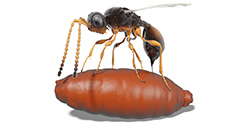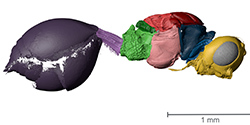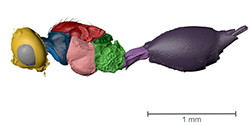Parasites Discovered in Fossil Fly Pupae
31 August 2018
Heidelberg researchers provide mathematical algorithms and software for digital reconstruction
Video: Thomas van de Kamp, KIT; Nature Communications
Parasitic wasps existed many million years ago: an international research group including Heidelberg scientists has succeeded in gaining important findings on the evolution of parasitism. Thanks to ultrafast X-ray imaging, it has been possible – for the first time – to prove the presence of parasitic wasps inside their hosts. Four extinct and previously unknown wasp species were newly discovered and described. Researchers at Heidelberg University developed dedicated mathematical algorithms and the software for the digital reconstruction.
The studies were based on over 1500 fossils, which belong to the collections of the Natural History Museum in Basel (Switzerland) and the Naturhistoriska Riksmuseet in Stockholm (Sweden). They are mostly mineralised fly pupae, which were found in late 19th century phosphorite mines in Quercy in southern France. Basel entomologist Eduard Handschin described them in detail as early as 1944. He pointed to the special importance of the externally inconspicuous pieces that were only about three millimetres long. Handschin had suspected the contours of a parasitic wasp in a fly pupa in that was estimated at 34 to 40 million years old, but this could not be definitively proved with the methods used at the time.

Figure: Thomas van de Kamp, KIT; Nature Communications


Using synchrotron X-ray microtomography it is possible today to gain access to the insides of objects that are millions of years old. The inner structures can be observed non-invasively and in three dimensions. The fly pupae were X-rayed at the UFO high-speed tomography station of the KIT synchrotron. The project was also coordinated at the Karlsruhe Institute for Technology (KIT). After the imaging of the fly pupae, the parasitic wasps were digitally reconstructed with high resolution.
This reconstruction was carried out using the Biomedical Image Segmentation App (Biomedisa). The web application was developed at the Engineering Mathematics and Computing Lab, headed by Prof. Dr Vincent Heuveline at the Interdisciplinary Center for Scientific Computing at Heidelberg University. “Biomedisa is able to generate ultrafast analyses of very big sets of three-dimensional imaging data, like that produced by synchrotron X-ray microtomography,” says Prof. Heuveline, who also heads a research group at the Heidelberg Institute for Theoretical Studies (HITS).
In addition, individual objects are labeled in the data in order to present them three-dimensionally and use them for further analyses. “This segmentation is frequently still carried out manually due to the complexity of observing the object. It takes several weeks, even months, in order to build the 3D model of a very big set of data,” explains doctoral student Philipp Lösel, who played a major part in developing the web application. On the basis of high-performance computer technologies working in parallel, the Heidelberg scientists have – with Biomedisa – developed a segmentation procedure that reduces the work of a few weeks to a few hours.
Thanks to the collaboration between different disciplines, the international research team was able to discover 55 parasitation events and describe four extinct wasp species that were unknown until now. The four different species are parasites that develop inside their host – in this case the fly pupa – which lived in the period around 40 to 23 million years ago. The project results provide important evidence on the evolution of parasitism, which is widespread and essentially characterises ecosystems. Today about 50 percent of all animal species are deemed to be parasites. The connection between biodiversity and parasitism is shown particularly clearly in the insect order Hymenoptera, to which wasps belong.
The research findings were published in “Nature Communications”.

